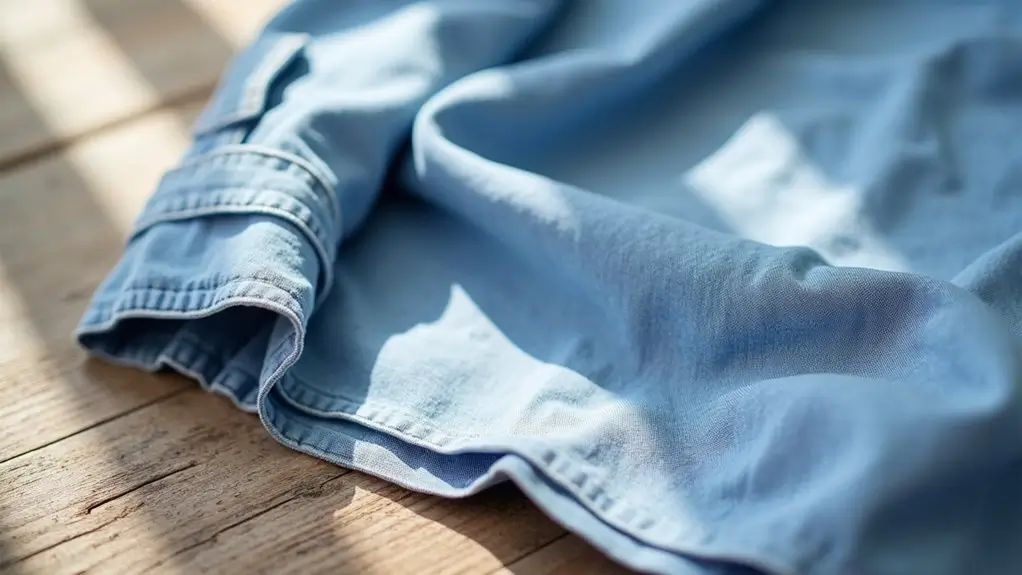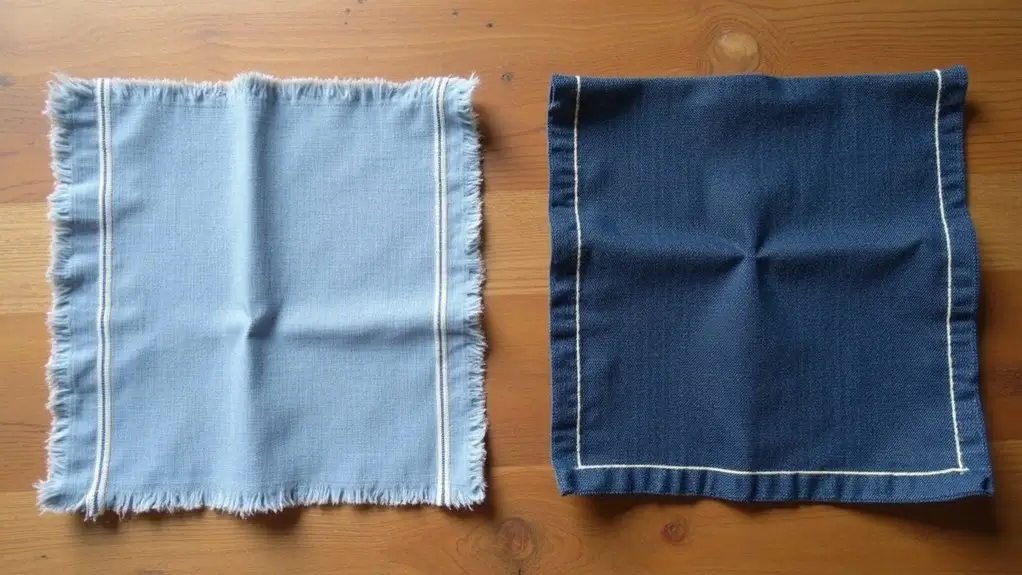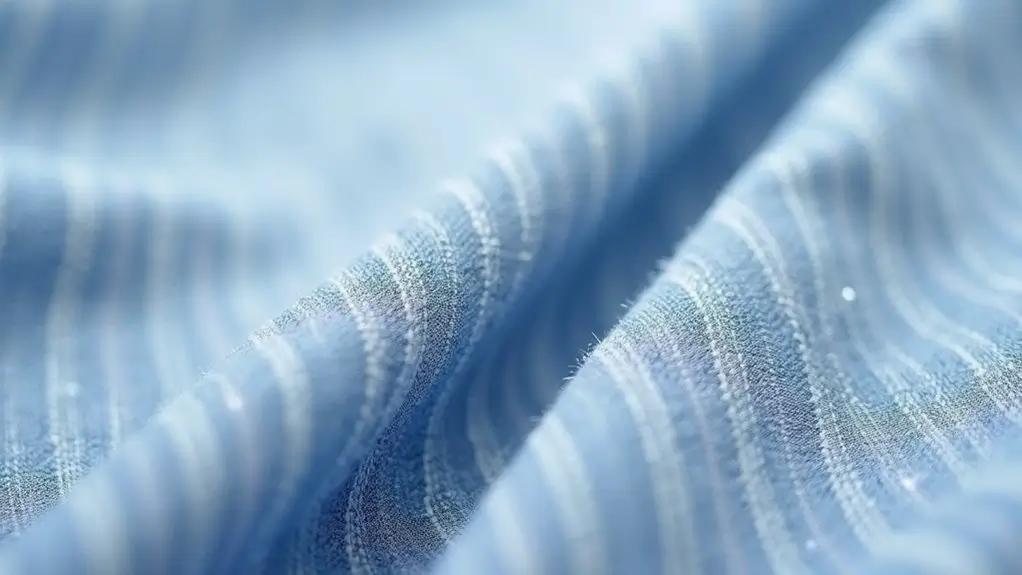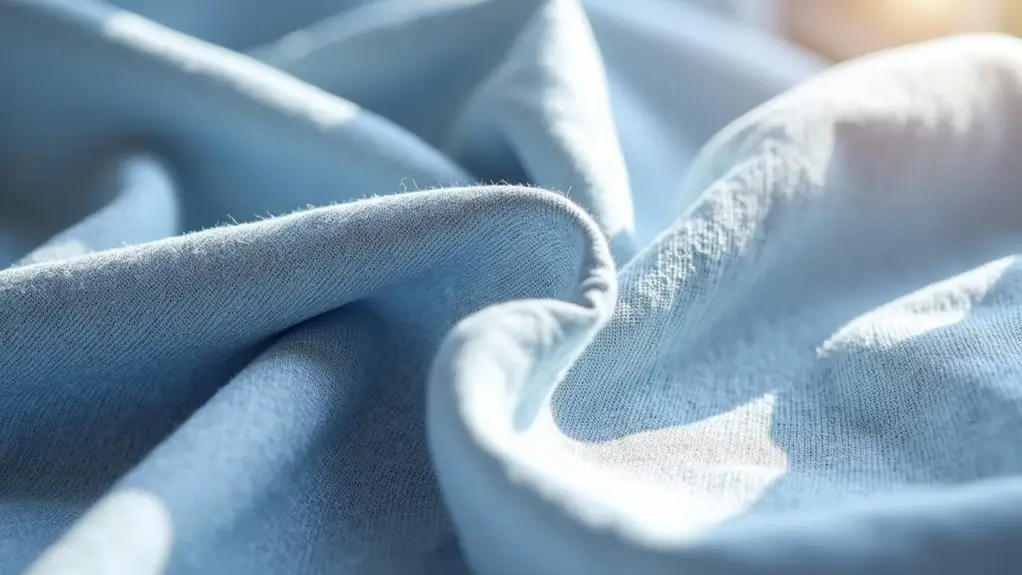You've likely encountered chambray fabric in your wardrobe, even if you haven't known its name. This distinctive textile, originating from Cambrai, France, offers a refined alternative to denim while maintaining similar visual appeal. When you examine chambray closely, you'll notice its characteristic plain weave construction: colored warp threads interlacing with white filling yarns. Understanding this unique fabric's composition and versatility will help you make informed choices about its applications in both fashion and home décor.
Key Takeaways
- Chambray is a lightweight cotton fabric made with colored warp and white filling yarns in a plain-weave construction.
- Originally from Cambrai, France, chambray uses a simple over-under weaving pattern that creates breathable, comfortable textile.
- Unlike denim's twill weave, chambray's plain weave results in a softer, lighter fabric ideal for warm-weather clothing.
- The fabric maintains durability while offering versatility for clothing, home décor, and crafting projects.
- Chambray softens over time and requires simple maintenance with cold-water washing and low-heat drying.
Introduction to Chambray

You'll find chambray to be a plain-weave cotton fabric with a rich history dating back to the 1500s in Cambrai, France, where it originated as cambric fabric.
The material's distinctive construction features dyed warp yarns interwoven with white filling yarns, creating a fabric that's lighter and more breathable than denim while maintaining a similar appearance.
The versatile textile has evolved from its working-class roots to become a staple in modern fashion, offering exceptional comfort through its softer texture and finer thread count compared to traditional denim.
What is Chambray Fabric
Chambray fabric stands as a distinctive cotton plain-weave material characterized by its colored warp yarns and white filling yarns. You'll find it's lighter and more breathable than denim, making it ideal for warm-weather clothing.
While both fabrics share similar colored warp and white weft construction, chambray's plain weave differs from denim's twill weave, resulting in enhanced softness and flexibility.
Cotton chambray offers remarkable versatility, from shirts to dresses, while maintaining excellent breathability. The fabric's environmental impact varies based on production methods, with organic cotton options providing more sustainable choices.
Modern chambray continues to evolve, offering various weights and finishes while retaining its signature lightweight characteristics.
History of Chambray
While many modern fabrics trace their origins to the Industrial Revolution, the history of chambray extends back to the 1300s when French weaver Baptiste first developed this distinctive textile.
Originally known as cambric in the 1530s from Cambrai, France, chambray faced challenges when British laws banned French fabrics in the 1700s. This restriction led manufacturers to source Indian cotton as an alternative.
The textile gained significant popularity during the 19th century, particularly as workwear, due to its durability and breathability. The fabric's characteristic construction, featuring colored warp and white weft yarns, created a lightweight, versatile material that would become a staple in modern fashion.
Characteristics of Chambray Fabric
Distinguished by its unique plain-weave construction, chambray fabric combines colored warp yarns with white weft yarns to create a lightweight, breathable textile.
You'll find this versatile material softer and thinner than denim, making it ideal for warm weather wear.
The fabric's distinctive characteristics come from its simple over-under weaving pattern, where dyed warp yarn intersects with white filling yarn.
This construction creates a balanced, even appearance on both sides of the material, enhancing its breathability and comfort.
Chambray's softer texture and lightweight nature make it adaptable for various garments while maintaining its classic, refined appearance.
Chambray vs Denim

The structural differences between these two cotton fabrics lie in their fundamental weaving techniques and material composition.
While both chambray vs denim use colored warp and white weft yarns, they're woven differently. Denim employs a twill weave creating its distinctive diagonal pattern, while chambray uses a plain weave resulting in a smoother surface.
You'll find chambray's lightweight nature makes it more breathable fabric than denim, with a higher thread count contributing to its refined texture.
Though denim offers superior durability, chambray provides versatility and comfort. Even softer than linen chambray variants, cotton chambray delivers an ideal balance of structure and airiness.
How Chambray Fabric is Made

Chambray's distinctive appearance emerges from a plain weave construction where colored warp yarns interlace with white weft yarns at right angles.
You'll find chambray primarily woven from cotton fibers, though manufacturers sometimes incorporate linen or silk to achieve different textures and performance characteristics.
The fabric's unique construction requires precise tension control during weaving, resulting in a lightweight material that's both breathable and durable when properly maintained through cold-water washing and low-heat drying.
The Weaving Process of Chambray Fabric
Woven through a distinctive plain-weave construction process, chambray fabric emerges from the interweaving of colored warp yarns with white weft yarns. The weaving process creates a balanced interlace where each warp thread passes over one weft thread, then under the next, forming a simple yet effective grid pattern.
Unlike denim's twill weave, chambray's plain-weave fabric made from cotton or linen fibers produces a lighter, softer feel. The materials used typically include fine-count yarns that contribute to the fabric's characteristic lightweight nature.
When the colored warp and white weft threads interlace, they create chambray's signature subtle, heathered appearance.
Materials Used in Chambray Fabric Production
While traditional chambray production relies primarily on cotton fibers, modern manufacturing incorporates diverse materials including linen, silk, and synthetic blends to achieve varying textures and performance characteristics.
The textile industry now combines these materials in the distinctive chambray weave, where colored yarn forms the warp and white yarn creates the weft. Cotton remains the most popular choice due to its breathability and durability, while linen offers enhanced moisture-wicking properties.
The environmental impact varies by material choice - natural fibers like cotton and linen provide biodegradable options, whereas synthetic blends offer improved wrinkle resistance and longevity.
Care Instructions for Chambray Fabric
The proper care of chambray fabric begins with understanding its distinctive plain-weave construction, where dyed warp yarns intersect with white filling yarns to create its characteristic appearance.
To maintain your 100% cotton chambray's integrity during everyday wear, wash with cold water to prevent shrinkage and color fading.
You'll notice the fabric develops a softer texture with each wash cycle. Always tumble dry on low heat, as high temperatures can compromise the fabric's structure.
For wrinkles, which are common in chambray, press with steam using your iron's cotton setting.
These care instructions will help preserve your chambray's distinctive look and comfort.
Popular Uses of Chambray Fabric

Chambray's versatility extends across fashion applications where you'll find it in shirts, dresses, and accessories that capitalize on its breathable, denim-like aesthetic.
You can incorporate this adaptable fabric into home décor through upholstery, curtains, and table linens, leveraging its durability and textural appeal.
The fabric's medium weight and plain weave construction make it ideal for DIY crafting projects, from tote bags to quilting, where you'll benefit from its ease of cutting and stitching.
Fashion and Apparel Applications
Popular among fashion designers and consumers alike, chambray fabric has established itself as a versatile staple in modern wardrobes through its adaptability across multiple garment types.
You'll find chambray shirts leading the apparel category, offering a perfect balance of comfort and style. The weave fabric's breathable nature makes it ideal for summer clothing, from dresses to lightweight jackets.
Chambray outfits can be dressed up or down, allowing you to express your personal style while maintaining comfort. The fabric's ability to soften over time, combined with its year-round wearability, makes it a practical choice for diverse wardrobe applications.
Home Decor Items Made from Chambray
Beyond its prominence in fashion, chambray fabric has found its way into contemporary home interiors through various decor applications.
You'll find this versatile textile enhancing living spaces through lightweight curtains that filter natural light while maintaining breathability. The durability of chambray makes it ideal for upholstery projects, from accent chairs to headboards.
Its cotton composition works particularly well for table cloths and napkins, offering a casual yet refined alternative to white linen. The fabric's inherent softness and medium weight also make it suitable for decorative throw pillows, bed runners, and casual slipcovers.
Chambray in Crafting and DIY Projects
Crafting enthusiasts have embraced chambray fabric for its versatile nature and ease of manipulation in DIY projects. Since chambray is usually made with a colored warp thread and white yarn in the weft, it's perfect for creating custom home accessories and garments.
You'll find its similar weave and denim-like appearance ideal for quilting projects, tote bags, and decorative pillowcases.
While chambray is often mistaken for denim, its lighter weight makes it easier to layer and work with. The cotton construction offers superior breathability, making it an excellent choice for summer crafting projects like sun hats, lightweight scarves, and fabric-covered notebooks.
Frequently Asked Questions
Can Chambray Fabric Be Waterproofed for Outdoor Wear?
You can waterproof your chambray using silicone-based or fluoropolymer fabric treatments, though they'll reduce the fabric's breathability. The cotton fibers will accept waterproofing compounds, but you'll need periodic reapplication for continued effectiveness.
Does Chambray Fabric Pill or Fade After Multiple Washes?
You'll notice chambray's cotton fibers can pill with repeated friction, and the dyed warp yarns may gradually fade after multiple washes. Using cold water and gentle cycles will help minimize both pilling and color loss.
Is Chambray Suitable for Winter Clothing or Only Summer Wear?
While you'll find chambray's lightweight cotton weave best suited for summer wear, you can layer it in winter. Its thin construction won't provide significant insulation alone, making it less ideal for cold-weather primary garments.
Can Chambray Be Blended With Synthetic Materials for Better Durability?
You'll find chambray commonly blended with polyester, nylon, or spandex to enhance durability and stretch. These synthetic blends maintain breathability while adding wrinkle resistance and shape retention to the traditional cotton weave.
How Does Chambray Fabric Perform in High-Humidity Tropical Climates?
You'll find chambray performs well in tropical climates due to its breathable cotton composition and lightweight plain weave. It'll wick moisture effectively, while its thin construction allows air circulation, keeping you cooler in humid conditions.
Conclusion
Chambray's unique plain-weave construction sets it apart as a technical achievement in textile manufacturing. You'll find its defining characteristics in the colored warp and white weft yarn interaction, creating a distinctive cross-section that's lighter than denim. The fabric's 1:1 weave ratio guarantees peak breathability and durability, while maintaining structural integrity across diverse applications. When selecting chambray, you're choosing a textile that exemplifies precision engineering in weave architecture.


0 comments